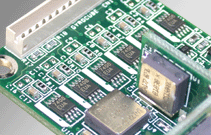
Q
- What angular rate and acceleration output ranges are available?
A - Rate ranges are ±300°, ±150°, ±75°, ±45° and ±22.5°/sec
and ±1 or ±2g acceleration (set at factory).
Q - Can
I change rate and acceleration gains?
A - Yes, however the user would need to replace 12 resistors,
documented in user manual.
Q - What
output can I expect from the analog IMU's?.
A - Analog IMU's provide buffered signals 0-5V (nom.)
with centers at 2.5V (nom). Details are available in the user manuals.
Q - What
is the data format of the digital IMU?.
A - Two output formats are available. An NMEA like ASCII
string with seven fields, representing X, Y and Z angular rate; X, Y
and Z acceleration and temperature all in 10 bit resolution (0-1023).
A 14 byte binary format is also available, both formats are user selectable.
Additional details available in the user manual.
Q - Why
do I need the anti-aliasing filters provided on the Gyrocube 3F?
A - The Gyrocube 3F is configured such that the sensor
outputs bandwidth are beyond 100Hz with the anti-aliasing filters set
for standard corner frequency of 37Hz. This assures flat response in
the passband with a sharp roll-off and a -53dB stopband attenuation.
Customers can order corner frequencies down to 1Hz. This can be particularly
useful in attenuating unwanted mechanical effects in vehicles
Q
- How much does an IMU weigh?
A - The Gyrocube 3A weighs 20grams.
Q - Are
there special concerns for the IMU power source?
A - As with all analog circuits, care should be exercised
to minimize the introduction of electrical noise into any desired signal.
Some common power supply practices are outlined in the user manuals.
Q - What
does 'integrated autopilot' mean?
A - We consider an integrated autopilot a complete solution
to stabilize, control and navigate an autonomous vehicle. Our integrated
autopilots are complete with static and dynamic pressure sensors, GPS
receiver and triaxial IMU.
Q - Is
an autopilot only useable on aircraft?
A - No, we have successfully tested these autopilots
on autonomous aircraft, boat and car platforms. See our gallery.
Q - What
else do I need to fly an aircraft with the PhoenixAX?
A - At minimum you need a vehicle, an appropriately
sized battery, pitot-static plumbing, servos for the control surfaces
on your airframe and a PhoenixAX autopilot. You can add optional sensors,
such as sonar altimeter, magnetometer compass or telemetry link.
Q - Is
software included with the PhoenixAX?.
A - Not currently. An optional software package will
shortly be available. The PhoenixAX is a hardware platform for developing
autopilot software. O-Navi supports the Autopilot Open Source Initiative
to aid software developers and advance the state of the art of autopilot
and autonomous vehicle control systems.
Q - Can
I connect the VCC directly to a unregulated power source.
A - Yes, the PhoenixAX can be powered by 10-24V unregulated.
It is highly recommended that users add noise filters to prevent RF and
noise from other systems aboard your vehicle from interfering with the
autopilot.
If you have a question
not addressed here, please feel free to contact
us.
For more information go to our SUPPORT page.